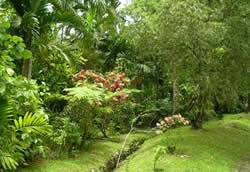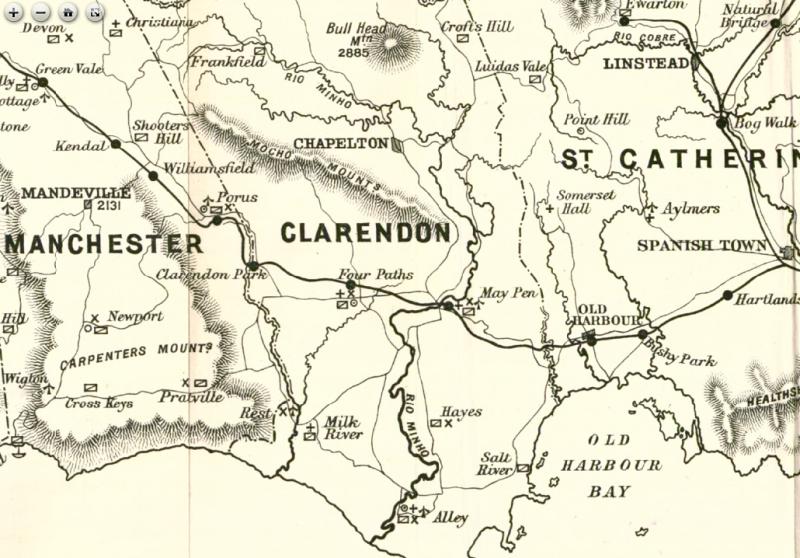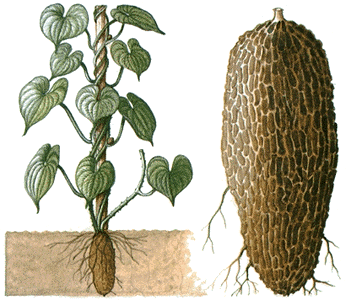| Works of Annie Fields |
by
Annie Fields
1896
Part 4 -- January 31 - February 4
Jamaica
[ Friday 31 January through Sunday 2
February. ]
Friday Jan. 31st Kingston Harbor. Again a night of glory! The moon on the mountains and the sea! There was no martial music from the Royal Ships but there was stillness everywhere. Even an occasional boat would pass us silently as if the quiet was too sacred to be broken. This morning there are soft shadows and a few clouds around the mountains, but a white mist has settled upon the plain where Kingston lies. Why could not English eyes have seen these poisonous mists before sacrificing thousands of brave men here.* At last they have learned the lesson and their troops lie high up on the mountains where in hours they can be called to the field. [Deleted word]
The Hermione is to be thoroughly cleaned here and we shall stay
several days -- long enough to find ourselves ^somewhat^
acquainted with the place ^island^. [Deleted
word]
We left soon after breakfast for a visit of exploration over
the
island driving first over a level dusty road six miles to
Constant Spring Hotel a place much frequented during the summer
by Kingston people.* The hotel which is a
Page 55
large one, built of limestone and cement with wide piazzas and
a roof of wood, was built by an American company but it was a
wild and fruitless scheme and the English syndicate
^government^ which sold them the land was obliged to take the
whole thing upon their ^its^ hands in order to get their
^its^ money back. The house stands rather high 500 feet I
believe, above the sea and there is a fine spring of clear cool
water -- enough for ^a large^ ^swimming^ bath, but [Several
deleted words] ^the vicinity is a naked^ wilderness; in
the
vicinity as it seemed ^at least such it
appeared^ to us. I dare say it was really more attractive
than we thought it however because there were English people
with bicycles who found the country beautiful. It was a
great drawback to us tro to hear that the [grass written
over
another word] was full of "ticks" and that we must not
[stroll written over another word] away from the
house. It was a drawback to the imagination rather
than a reality we faced ---- The sun was intensely
hot and after a pleasant luncheon with Star apples, mangoes,
pineapples and delicious oranges beside other more substantial
things, we found ourselves so glad to be perfectly still
once more that I believe we hardly moved anyone of us from
our shaded balcony rooms until evening -- when we joined our
companions and walked about the endless piazzas until
dinner. How good it was to read and write in peace during
the afternoon! I read the Bonnie Briar Bush by Ian
Maclaren and cried and cried over the doctors story, one of the
most exquisite things in all literature putting the writer by
the side of our beloved Dr. John Brown* which I thought no
man
Page 56
could ever make me say! We slept that night "indifferent well" in our new lodgings -- nevertheless we waked refreshed. It was so much cooler than our late weather that the change gave a sense of restlessness.
We left Constant Spring in the cool of the morning the moon in
the sky, for a long drive westward into the mountains to
Castleton Gardens* which we reached before ten
o'clock. All the way up we could look into deep valleys of
^filled with^ cane and tobacco planted upon slopes leading to a
fine river called "Wag Water".* The land was not only
fertile from cultivation -- the noble trees were a fresh delight
on every hand and were dancing over every stone wall.
There is, however much more cultivation of the soil than we give
these poor "brown men" credit for. It is their own land
(there are 700,000 inhabitants in this island 49 miles wide and
149 miles long. The percentage of whites is very small -- there
are about 50,000 I believe altogether)* and in spite of its
natural fertility it is surely no discredit to the colored
people especially when they are led by the example if not by the
direct master-ship of the white people. At Castleton there
was a little group of cottages belonging to the fruit company
and a restaurant. They stand overlooking the garden.
It must be a pretty residence and escape from Kingston which is
hotter and dustier and more impossible for a residence than any
place I ever saw except Port au Prince yet I will admit there is
a long distance between ^them^
in favor of Kingston, which has a good government and a respectable white population who live in its vicinity. Part of our beautiful drive to Castleton was through the gardens of the King's House ^more precisely the Governor's house^ and we could [confess ?] nothing lovelier. The road itself before we reach the gates and after we part with the Kingston dust is damp and cool and flower fringed but as we approach the gates the mountains rise and fill the distance with their blue slopes while the foreground is filled as it were to the base of the mountains by an avenue of the most brilliant flowers. We have seen no garden to compare with it! Perhaps there is nothing in the world more beautiful. The avenue and garden lead finally to the house of course and not into the mountain, but the effect is enchanting. The soldiers allowed us to drive through without challenge{;} indeed the general at the house advanced as if to welcome us but we only bowed and drove on. We left Castleton again after an early luncheon returning to Kingston where we took the train to Porus, a small station, whence we took course again to Mandeville for Sunday, a place recommended for the beautiful mountain air. It must have been 8 o'clock Saturday evening Feby 1st when we came to Mandeville driving 8 or 10 miles in the dusk and dark -- but the horses in our carriage, though not in the one behind were excellent and we trotted along over the
Page 58
fine English road drinking in the air after our hot day with
immense satisfaction -- We came at last to a strange
looking little inn called the Brooks ^or Waverly^ House I
believe kept by a native white woman evidently of Jewish
extraction and her young brother.* The colored servants
came quickly to our assistance and "Topsy"* who was head
waitress was very efficient. Topsy wore a small white cap
on the very top of [deleted word] her black wool, but the
others wore handkerchiefs or turbans. We were very tired
with our long day and glad to go to bed after such a long
travel journey but it was all strange enough ^to be
interesting [enough to tired eyes ?]:^ the rooms
being built like a piazza{,} the partitions not always running
to the top of the rooms and we were made acquainted more or less
all night with the movements of our fellows -- but it was cool
and decent and we slept well finding ourselves Sunday Feby 2d
2300
feet above the sea on an open hilly plain with an
scattered English settlement around us, a race-ground a little
market and a large old English church.* It is showery and
soft, flowers were blossoming in the garden, geraniums, roses
and lilies. The red earth and the limestone making a
pleasant combination for the eyes, overhung by green
everywhere. Topsy and company began to come to our rooms
at half past six, first with tea then with hot water, then for
shoes, then for the vessels, all in slow succession, until I
locked my door in desperation and began to
Page 59
bathe in my washbowl and without a [rag ?] after the
fashion of such places. It could not be called the height
of comfort but it was good enough which is saying a good
^great^ deal for the landlady under the circumstances. [deleted
words] An equally remote place in New England would not
have been better perhaps. The table was rich in oranges
the very best we have seen. The finest I have ever
seen. Mandeville is famous for them. They are cheap
{.} We brought away a large basket {of} three dozen at the
cost of two shillings.
We walked over to the church. Many races and every shade
of brown man and woman were to be seen -- but how beautiful it
is to join together in worship with such a company. We
enjoyed it to the full and had a good sermon from the English
preacher. The singing too was by the people apparently,
led by a selected company who sat in the chancel and was full of
spirit -- sometimes a sense of wildness from the voices of the
"brown people" rising in the old chants best known to
them. The rain came spattering down on the time stained
roof and stones as we sat there, but the sun was shining again
when we came out into the warm but inspiring air. The
grass was greener the earth was redder the mountains more
elusive the flowers more brilliant than ever. The roads
deep cut between flowery banks reminded one of Devonshire.*
Notes
sacrificing thousands of brave men here: Wikipedia
says: "Newcastle [Jamaica] became a military centre in the 1840s
when Major General Sir William Maynard Gomm, Lieutenant Governor
of Jamaica (and Britain's longest serving soldier), observed
that yellow fever, a major cause of death among the British
troops stationed in Jamaica, was far less prevalent in the
mountains. After unsuccessful attempts to persuade the
government to pay for the construction of a military barracks up
in the hills, Gomm went ahead with construction of the barracks
at the Newcastle coffee plantation on his own initiative.... The
death toll among the troops posted to the West Indies garrison,
formerly regarded as virtually a death sentence, declined
dramatically." Until the early 20th century, it was widely
believed that low-lying
mists were a direct cause of several tropical diseases,
including Yellow Fever.
Constant Spring Hotel: 1905 image of the Constant
Spring Hotel near Kingston (Pinterest).
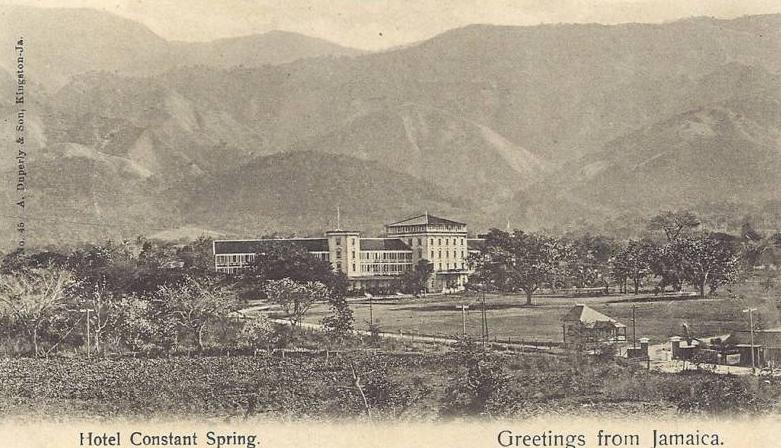
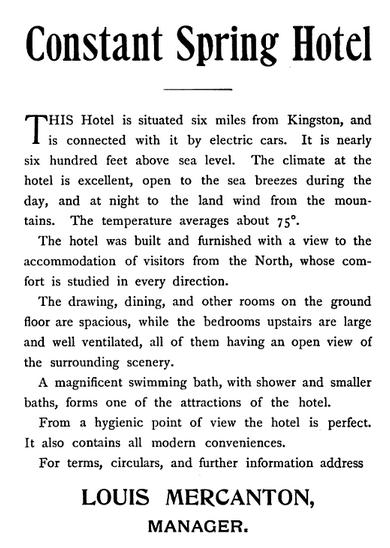
Ad for the Constant Spring Hotel
Stark's
Jamaica
Guide: Containing a Description of Everything Relating to
Jamaica (1902)
p. 224
Bonnie Briar Bush by Ian Maclaren ... our beloved Dr. John
Brown: Wikipedia
says: Ian Maclaren (pseudonym of Rev. John Watson; 3
November 1850 – 6 May 1907) was a Scottish author and
theologian." Beside
the
Bonnie Brier Bush (1894), contains stories of
rural Scottish life. A 2007
ad for this title describes it: "Ian Maclaren's Beside
the
Bonnie Brier Bush is one of the most notorious works of
Scottish literature. First published in 1894, the book was an
instant best-seller. Millions of readers across the world rushed
to devour these nostalgic tales of Scottish life in a bygone
age. Based on the author's experiences as a Free Church minister
in rural Perthshire, the book captured the contemporary taste
with its blend of humour and pathos and its racy Scots
dialogue."
Wikipedia
also says: "John Brown (22 September 1810 – 11 May 1882) was a
Scottish physician and essayist. He is best known for his
3-volume collection Horae Subsecivae—"Leisure Hours"
(1858), including essays and papers on art, medical history and
biography. Among the former, his dog story, Rab and his
Friends (1859), and his essays Pet Marjorie
(1863)—on Marjorie Fleming, the ten-year-old prodigy and "pet"
of Walter Scott, Our Dogs, Minchmoor, and The Enterkine are
especially
notable."
westward into the mountains to Castleton Gardens:
Fields seems to have her directions mixed up, not surprising
when traveling through mountainous terrain. From Constant
Spring to Castleton is almost due north (see map below).
Castleton is on the Wag Water River, which flows into Annotto
Bay on the north side of the island, about 24 miles from
Kingston. According to Stark, by the 1890s, the Wag Water
had become an important part of Kingston's water supply.
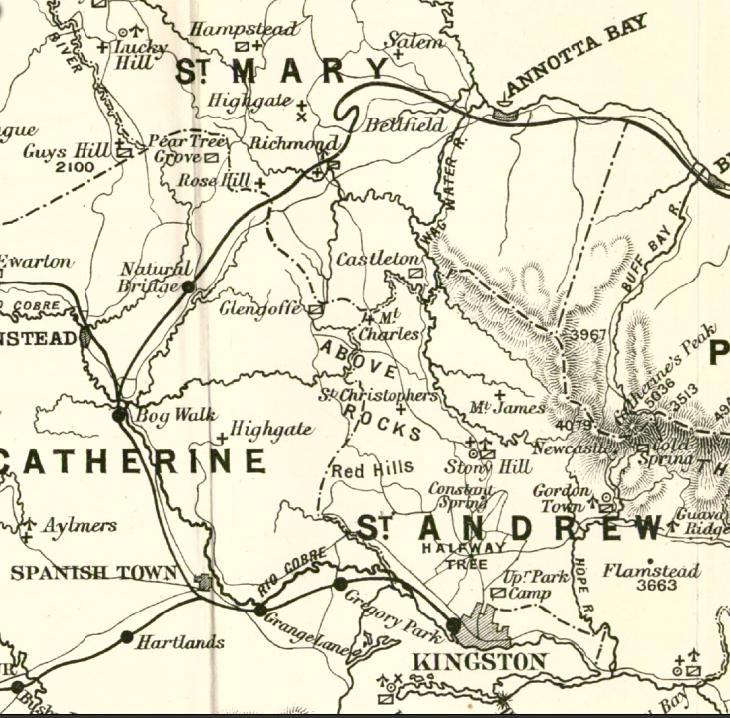
From 1896 Map Jamaica, east central portion
Courtesy of Digital
Library of the Caribbean
Wikipedia says: "In the 19th century, the British established a number of botanical gardens. These included the Castleton Botanical Garden, developed in 1862 to replace the Bath Garden (created in 1779) which was subject to flooding. Bath Garden was the site for planting breadfruit, brought to Jamaica from the Pacific by Captain William Bligh. It became a staple in island diets."
700,000 inhabitants in this island 49 miles wide and 149
miles long. The percentage of whites is very small ...about
50,000: The source of Field's numbers is not
known. Stark's Jamaica Guide says that in the 1891
census, there were about 640K inhabitants, of whom 14K
identified themselves as white, though Stark believes a
significant portion of these was of mixed heritage. He
gives the Chinese population as only 481 and the East Indian as
about 10K (pp. 186-7).
gardens of the King's House ^more precisely the Governor's
house^: Chapter 8 of Stark's Jamaica Guide
describes the five-mile drive from Kingston to King's House, the
governor's residence. The residence is north of the
village of Halfway Tree (see 1896 map above). Henry
Arthur Blake was governor of Jamaica, 1888-1897.
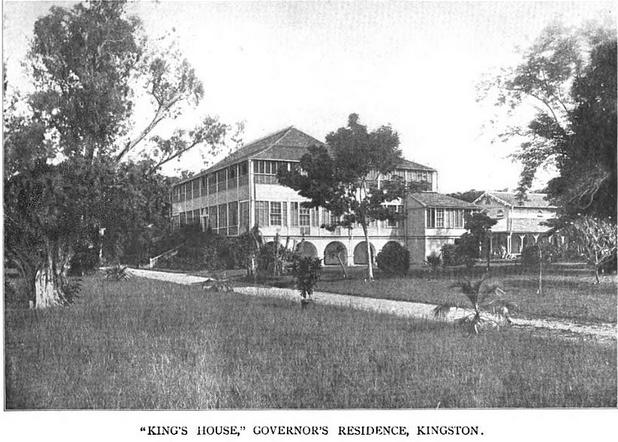
Porus ... Mandeville: Porus,
according to Stark's Jamaica Guide, p. 111, is named for
a companion of Columbus. Kingston to Porus is about 50
miles; Porus to Mandeville is about 10 miles. According to
Wikipedia, "Mandeville
is the capital and largest town in the parish of Manchester in
the county of Middlesex, Jamaica." Stark also provides a
fairly detailed description of Mandeville as an English village
in a tropical setting (pp. 112-6).
the Brooks ^or Waverly^ House ... a native white woman
evidently of Jewish extraction and her young brother:
Notes
on an 1895 photograph of this hotel on Flickr
includes this information: "The British established one of their
earliest 'hill stations' here and in 1875, the buildings
formerly used as officers' Quarters and Mess (left of the Court
House and central town square) became The Waverly
Hotel. Owned by A. A. Lindo, the 17-room hotel was
operated by Jane Brooks and the name was later changed to the
Brooks Hotel and then finally to the Mandeville Hotel."
For other images see: The
Mandeville
Hotel. Further information about Jane Brooks and her
family would be welcome.

Notice for Brooks Hotel in Stark's Jamaica
Guide, p. 225
"Topsy": It is not clear that Topsy is the actual
name of the Brooks Hotel employee Fields describes, especially
as the name appears in quotation marks. Almost certainly
Fields associates this woman with an abused slave girl in
Harriet Beecher Stowe's Uncle
Tom's
Cabin (1852), popularly known for her talents for
mischief, though, in the novel, she grows under loving Christian
guidance into an exemplary woman.
a race-ground a little market and a large old English church:
Stark
describes the market and race-ground in his account of
Mandeville (p. 112).
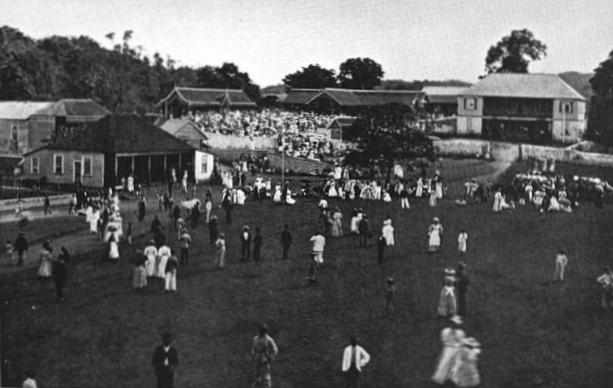
Mandeville Market from Stark's Jamaica Guide, p. 114
It is possible, but not certain, that Fields heard the preaching of Charles Frederick Douet during her visit to St. Mark's. Douet was appointed rector in 1892. This biographical sketch appears in Bishops of the Day... (1897) by Frederic Sawry Lowndes:
Douet, The Right Rev. and Ven. Charles Frederick,
assistant Bishop of Jamaica; Mandeville, Jamaica, West Indies, He is the son of the Rev. C. J. P. Douet, rector of Metcalfe, Jamaica, and was born in 1840. He was educated at Corpus Christi College, Cambridge, where he graduated B.A. in 1862 and M.A. in 1875, Ordained deacon in 1863 and priest in 1864. He was island curate of Bath from 1866 to 1867; curate of Birman Wood from 1867 to 1870; rector of Vere from 1870 to 1876; acting archdeacon of Middlesex from 1879 to 1884; rector of the Cathedral of St. Jago de la Vega, Spanish Town, from 1876 to 1891; and principal of the Government training college for schoolmasters from 1876 to 1890 -- all in Jamaica. He was appointed archdeacon of Surrey, Jamaica, in 1884, and was consecrated assistant Bishop of Jamaica on November 30, 1888, in Westminster Abbey. He received the Lambeth degree of D.D. from the Archbishop of Canterbury in 1889. In 1892 he was appointed rector of Mandeville, Jamaica. The Bishop married, in 1882, Ellen M., daughter of the Hon. Louis F. Mackinnon, of The Whim, Jamaica. (p. 87)
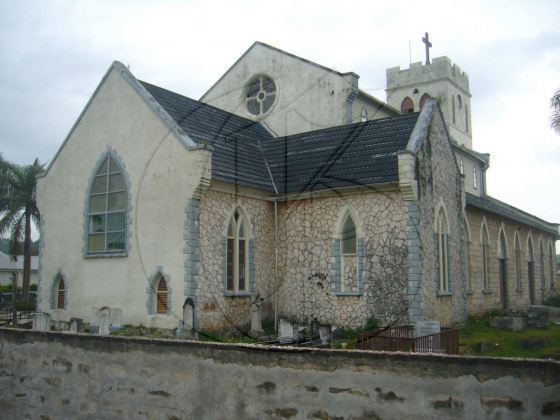 St. Mark's Church, Mandeville
Courtesy of The Gleaner. |
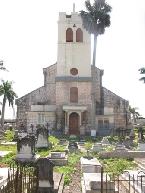 St. Mark's Church
Jamaica National Heritage Trust |
Devonshire: A county of
southwest England, previously visited by Fields and Jewett, and
used by Jewett for a setting in her novel, The
Tory
Lover (1901).
Monday Feb. 3d Drove away from ^Left^
Mandeville very early breathing the mountain air with delight as
we drove
Page 60
again past the fields of tobacco and cane [deleted word] on the verge of a mountain valley all the way where little streams came down on one side and the river rolled at the bottom on the other; the many hundred feet of flowering slopes covered with mango trees in blossom, wild fig trees, Ceiba trees,* and myriads of others. The yam is seen in every garden, the vine growing upon beanpoles.* It takes about nine months for the yams to ripen we are told. Therefore the potato is the vegetable for [deleted word] ^our climate^ which asks for only three or four.
We took the train for Spanish Town* where it was excessively warm again. The mountain breezes were behind us! It was only about ten o'clock when we arrived, but the town was already blazing with white light. However we had no walking to do and soon found ourselves upon the wide piazzas of the Rio Cobre hotel. There was a huge palm called the cabbage palm,* curious and beautiful, with a kind of second growth of something like cones at the roots of the branches which caused T. B. A. to say "that tree seems to feel that it cannot do enough." It stands in the middle of the little green square in front of the house, most shapely and ornamental. over the porch is a "Dutchman's pipe [" ?] vine with its splendid leaves and ripe seed vessels lovely in form, and ^a^ noble Hibiscus at one side lends color to the whole. The Lignum Vitae trees are also in full bloom now, spreading a mist of cool blue flowers in the air. This tree is not tall and does not stand against the blue of the sky
but overshadowed usually with other trees of larger growth so that its lovely blue blossoms are felt to be a cool flood of beauty among the more showy growths around it --
We enjoyed Spanish Town! The age of it (Columbus came to
this island of Jamaica in 1494) which antedates Kingston, and
the remains of brick walls and steps -- the old church where
there were stones of buried English people in 1620 and [deleted
word] were ^was^ well worth seeing. We were
sorry not to be there longer and if we return to Jamaica we
should like to stay there{;} it is so much more beautiful than
any other place to stay ^dwell^ in we have seen
except Mandeville which is too remote and not quite comfortable
for our party. On one side ^At Spanish
town^ the hotel looks into a deep valley ^on one side^ and up to
the hills, on the other with gardens and towards the town.
The former King's House, now the Queen's House, is seldom lived
in now, although Sir Henry & Lady Blake passed a few
days here with their family last month -- but it must be a labor
to make it habitable. The old kitchen was as large as the
old Oxford Halls. The fine statue of Rodney is
beautifully placed here in a kind of arcade -- a charming site
and good in a [unrecognized word]
arrangement for a fine statue it struck me -- one that would
suit our climate too much better than a
Page 62
the fashion of leaving them wholly exposed. But the old
church was the most interesting place of all. Here the
celebrated men and women who have been struck down in the new
land by war and by disease have had statues and written
memorials proving the sorrow and esteem for [ of was
intended?] the survivors, which out vie most of the
memorials in Westminster Abbey. One couldn't read them
without tears. One of the loveliest figures is one by
Bacon in memory of Lord and Lady Effingham. (I think
this is the name. She was of the family Bruces and
Kincaids of Scotland and he of the Elgins if I remember
well) The inscription written by the Assembly of Jamaica
was most touching{.}* ^No place could be^ more beautiful to live
in than Spanish Town if it were not the very heart of disease
and death {--} alas! This appears to be the truth.^
From King Spanish Town to Kingston where it was hotter
than ever. The Hermione had been brought to the dock and
there was very little air. We sat on the upper deck during
the evening watching the phosphorescent sea and the huge fish
(probably sharks which abound here) turning over making a white
light as they moved.
wild fig trees, Ceiba trees: Fig trees, though widely cultivated, grow wild in many species. Native to the Caribbean is Ficus maxima.
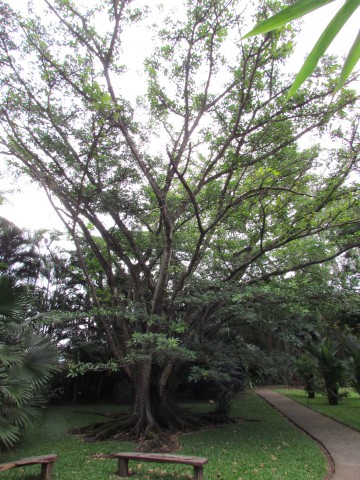
Ficus Maxima
Location: Costa Rica Botanical Orchid Garden
Photo Credit: Brandan Jones
Season: December 2011
Earlier in the diary (Part 2), Fields refers to the Ceiba as the silk-cotton tree. Wikipedia says: "Ceiba is the name of a genus of many species of large trees found in tropical areas, including Mexico, Central America, South America, the Caribbean, West Africa, and Southeast Asia. Some species can grow to 70 m (230 ft) tall or more, with a straight, largely branchless trunk that culminates in a huge, spreading canopy, and buttress roots that can be taller than a grown person. The best-known, and most widely cultivated, species is Kapok, Ceiba pentandra, one of several trees called kapok. " The following image of this tree growing in Hawaii, is from Wikipedia.
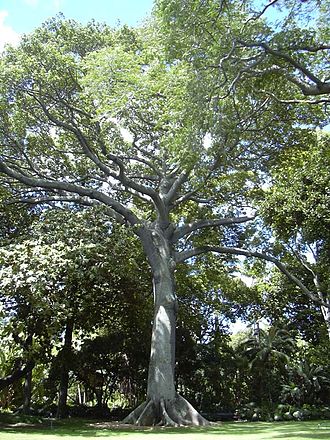
yam: Though sweet potatoes in the United States commonly are called yams, in fact, yams constitute a different unrelated species from sweet potatoes: Dioscorea cayennensis subsp. rotundata.
Spanish Town: Wikipedia says: "Spanish Town is the capital and the largest town in the parish of St. Catherine in the county of Middlesex, Jamaica. It was the former Spanish and English capital of Jamaica from the 16th to the 19th century. The town is home to numerous memorials, the national archives, a small population, and one of the oldest Anglican churches outside England." Spanish Town is about 13 miles west of Kingston (see 1896 map of east central Jamaica above).
Rio Cobre hotel. ... huge palm called the cabbage palm: Several palms are commonly called cabbage palm. Native to the Caribbean are Roystonea oleracea and Sabal palmetto. Fields's description and Aldrich's comments suggest that they are viewing a Sabal palmetto, but a period photo of the hotel, suggests they are observing Roystonea oleracea or perhaps another species altogether.
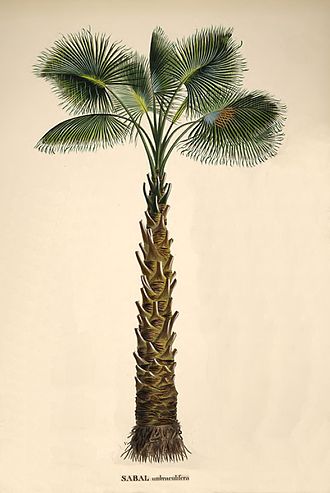 Image of Sabal palmetto
Courtesy of Wikipedia |
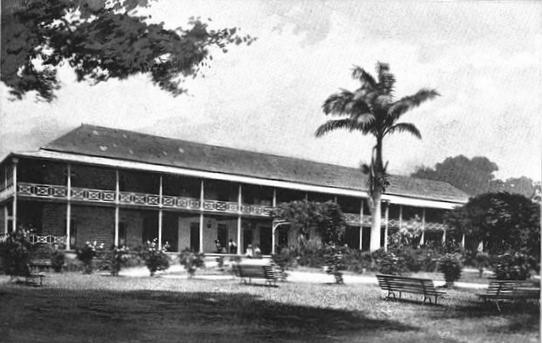 Rio Cobre (Copper River) hotel
from Stark's Jamaica Guide, p. 108.
With "Cabbage palm" in front, and Dutchman's Pipe vine over the porch. |
over the porch is a "Dutchman's pipe [" ?] vine ... lignum vitae: Dutchman's Pipe is a common name for the climbing vine Aristolochia. Wikipedia says: "Lignum vitae is a trade wood, also called guayacan or guaiacum ... from trees of the genus Guaiacum. The trees are indigenous to the Caribbean and the northern coast of South America and have been an important export crop to Europe since the beginning of the 16th century. The wood was once very important for applications requiring a material with its extraordinary combination of strength, toughness, and density. It is also the national tree of the Bahamas and the Jamaican national flower." Wikipedia also points out that the species are listed as endangered, though demand for them has decreased as they have been replaced with artificial materials.
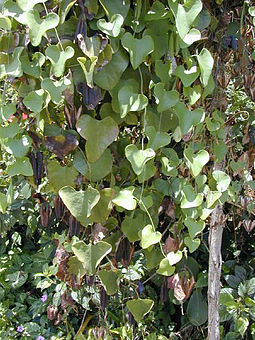
Dutchman's pipe vine
Courtesy of Wikipedia.
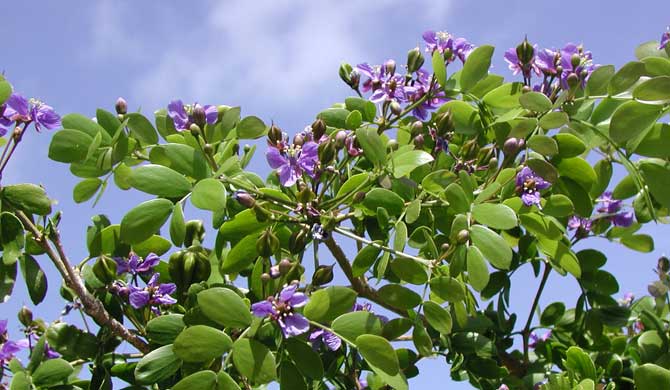
Lignum Vitae in bloom
Courtesy of Google Images
Web page reference link broken.
The former King's House ... The old kitchen was as large as the old Oxford Halls: Probably Fields exaggerates in suggesting the size of the King's House kitchen as comparable with a dining hall at an Oxford college, such as Merton College.
Jamaica Travel and Culture says: "Kings House was constructed in 1762 to be the official residence of the Governor of Jamaica. This was the first of the four great historic buildings to be completed around the Park. It served this purpose up until the transfer of the capital to Kingston in 1872.... The building ... was mostly destroyed by a fire in 1925. The façade of the original structure remains..."
Sir Henry a [and ?] Lady Blake: Probably Fields refers to Henry Arthur Blake (1840-1918), an Irish born British administrator who served as Governor General of Hong Kong (1898-1903). Appointed Governor General of Jamaica in 1888, he held that position until 1897. His wife was "Lady Edith Blake (1846 - 1926) ... an Irish botanical illustrator and writer, noted for her work on the flora and fauna of countries such as Sri Lanka, The Bahamas, and Jamaica."
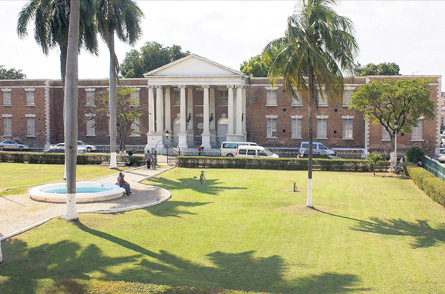
Image of King's House, Spanish Town
Courtesy of Jamaica Observer
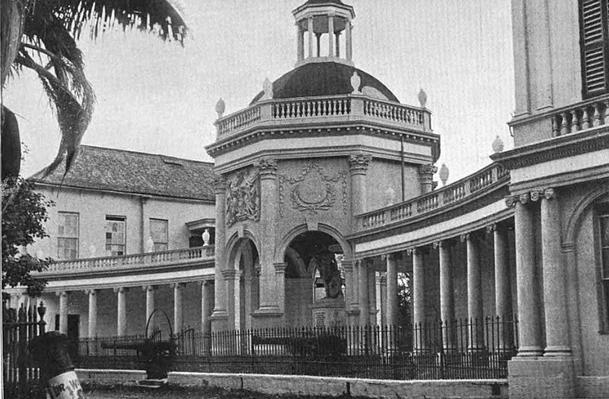
The fine statue of Rodney: See photo above for the "arcade" housing the statue of Admiral George Brydges Rodney, 1st Baron Rodney (1718-1792). Wikipedia says Rodney "is best known for his commands in the American War of Independence, particularly his victory over the French at the Battle of the Saintes in 1782." "The Battle of the Saintes (known to the French as the Bataille de la Dominique), or Battle of Dominica was an important naval battle that took place over 4 days, 9 April 1782 – 12 April 1782, during the American War of Independence, and was a victory of a British fleet under Admiral Sir George Rodney over a French fleet under the Comte de Grasse forcing the French and Spanish to abandon a planned invasion of Jamaica."
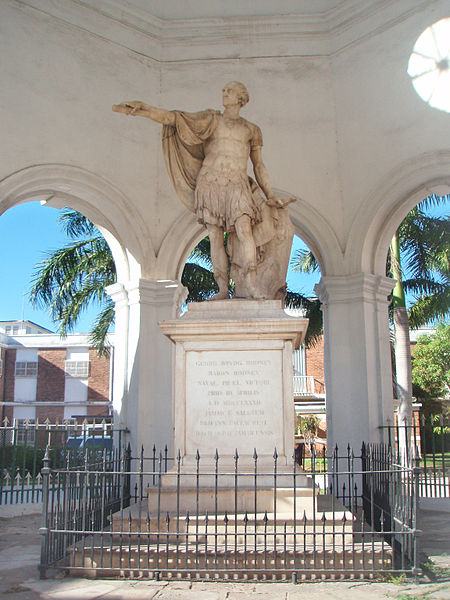
the old church ... the memorials in Westminster Abbey: Jamaica National Heritage Trust says: "The Spanish Town Cathedral, also known as the St. Catherine Parish Church, was built in the second half of the seventeenth century. After the conquest of Jamaica by the British in 1655, the British destroyed the original Catholic Church and replaced it with the Anglican Church, which is now the St. Catherine Parish Church or the Spanish Town Cathedral. In 1712 the church was destroyed by a hurricane, but rebuilt in 1714."
Westminster Abby in London, Great Britain, is known for its numerous monuments to British notables.
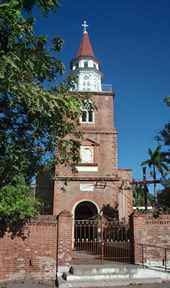
Image of St. Catherine Parish Church
courtesy of Jamaica National Heritage Trust
Bacon in memory of Lord and Lady Effingham. ... [she was of ] the family Bruces and Kincaids of Scotland and he of the Elgins: Stark's Jamaica Guide describes the cathedral and several of its monuments (pp. 106-7). John Bacon the Elder sculpted the Effingham monument that appears in St. Catherine's in Spanish Town.
Wikipedia says that Lieutenant-Colonel Thomas Howard, 3rd Earl of Effingham (1746 - 1791) was a British nobleman and Army officer who died a few weeks after his wife, while he was serving as governor of Jamaica. Wikipedia notes: "He is best known for resigning his commission in protest against the war against the American colonies." This would explain in part Fields calling attention to his monument. His career is summarized at Boston Castle: Rotherham. His wife was Catherine [or Katherine] Howard (Proctor), Countess of Effingham (1746-1791). It seems likely Fields is confused about their ancestry Though I have found no evidence to the contrary, I have not been able to confirm her information. Stark reports, for example another monument at St. Catherine's for Elizabeth Cumming-Bruce, Countess of Elgin, the first wife of James Bruce, 8th Earl of Elgin (1811-1863); she died in 1843, while Bruce was serving as governor of Jamaica (1842-1847). James Bruce and his first wife both are associated with the Bruce family name.
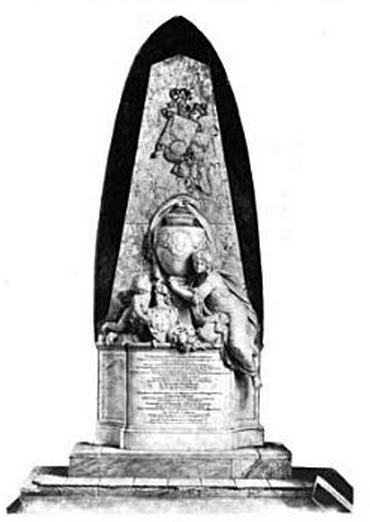
from "Sculpture in Jamaica" by Frank Cundall
Art Journal 69 (1907), p. 69
The inscription written by the Assembly of Jamaica: The Boston Castle article says: "A monument in statuary marble with a group of figures surrounding an urn, the work of John Bacon R.A., was raised over their joint tomb in the Cathedral of Spanish Town, paid for by the islanders at a cost of £8,000." The inscription on the tablet reads:
Of so illustrious a pattern of conjugal affection;
To manifest the public sense
Of the many public and private virtues of their respected Governor
And to record, for the benefit of posterity
The clearness of that sagacity
The extent of that knowledge
And the purity and firmness of that integrity
Which rendered his administration
The boast and security of a grateful people
Having caused the remains of this noble and Lamented Pair to be interred with funeral honours At the public expense, the whole House
Attending each procession as Mourners as a farther testimony of merited esteem inscribed this Monument.
According to Boston Castle Rotherham, this inscription is adapted from an epitaph poem by Bryan Edwards "To the Memory of Thomas, Earl of Effingham, Baron Howard," which appeared in The Scots Magazine and Edinburgh Literary Miscellany, Volume 7, pp. 444-5. The texts vary in these two sources; I have used the Boston Castle text, but corrected one line on the authority of the Scots Magazine text.
sharks: While there are numbers of sharks in Jamaica waters, it is not clear that they were observed often in Kingston harbor in the 1890s.
[ Tuesday 4 February ]
Tuesday 4th Went ashore for shopping in Kingston. It was less dusty than usual and appeared to better advantage. A little dépot [intended dépôt ?] called "Self Help" established by Lady Musgrave "Jeanie Field" attracted us and we saw that a beginning had been made
Page 63
to stop the beggary and dependence of the people. We also
found a little shop where good intelligent women put up
preserves etc: we tried them at dinner and found them
excellent. We were to have put to sea this afternoon but a
gale of wind detained us until [Next entry gives the date of
Wed. Feb. 5th]
Note
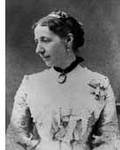
Lady Musgrave
Image courtesy of Geni
Edited by Terry Heller, Coe College.
The original of this diary is in the collection of the Massachusetts Historical Society. My copy is from a microfilm, available courtesy of the University of Kansas Libraries, Lawrence Kansas: Annie Adams Fields Papers 1852-1912. Folio PS 1669.F5 Z462 1986, Reel 2.
| Works of Annie Fields |
